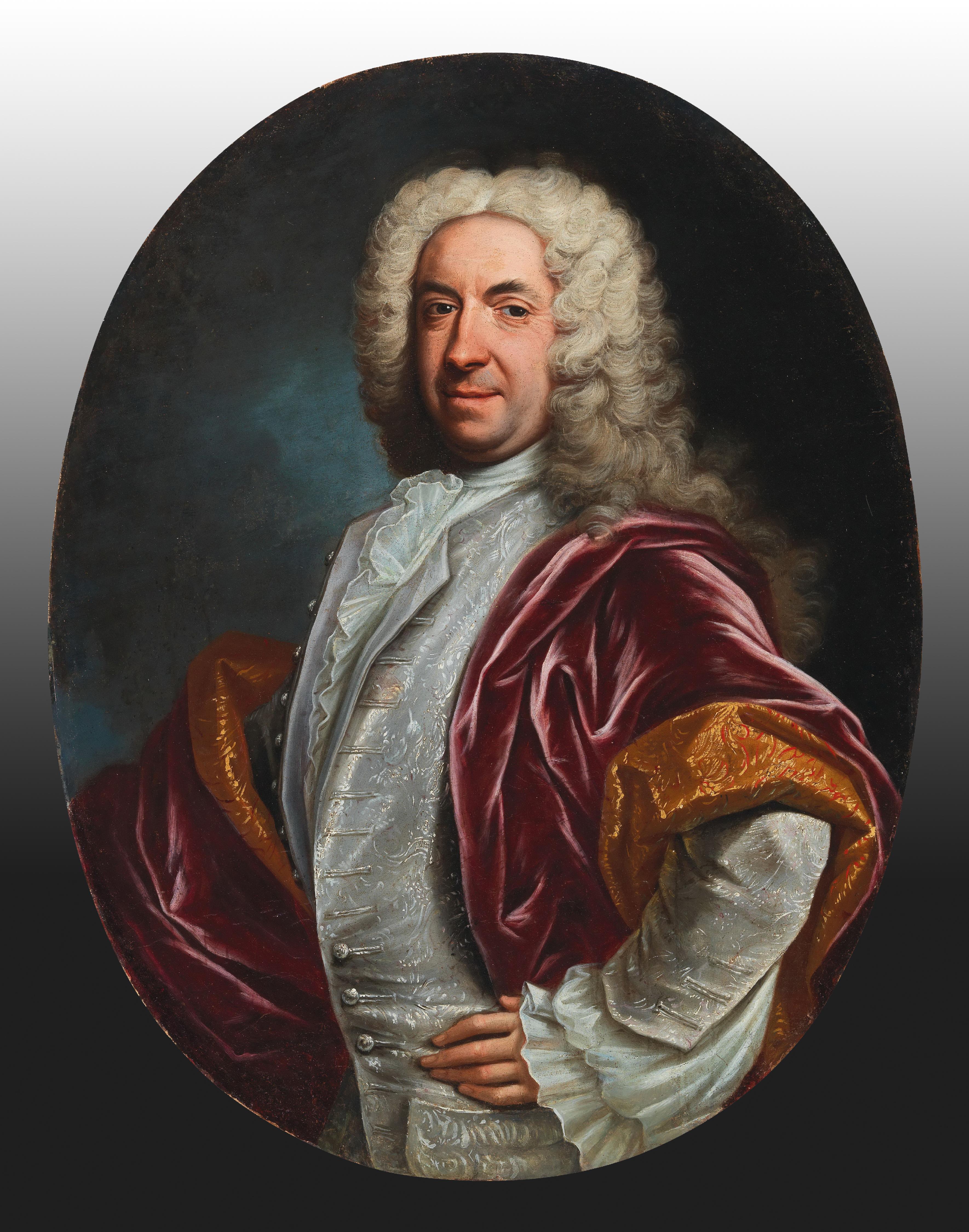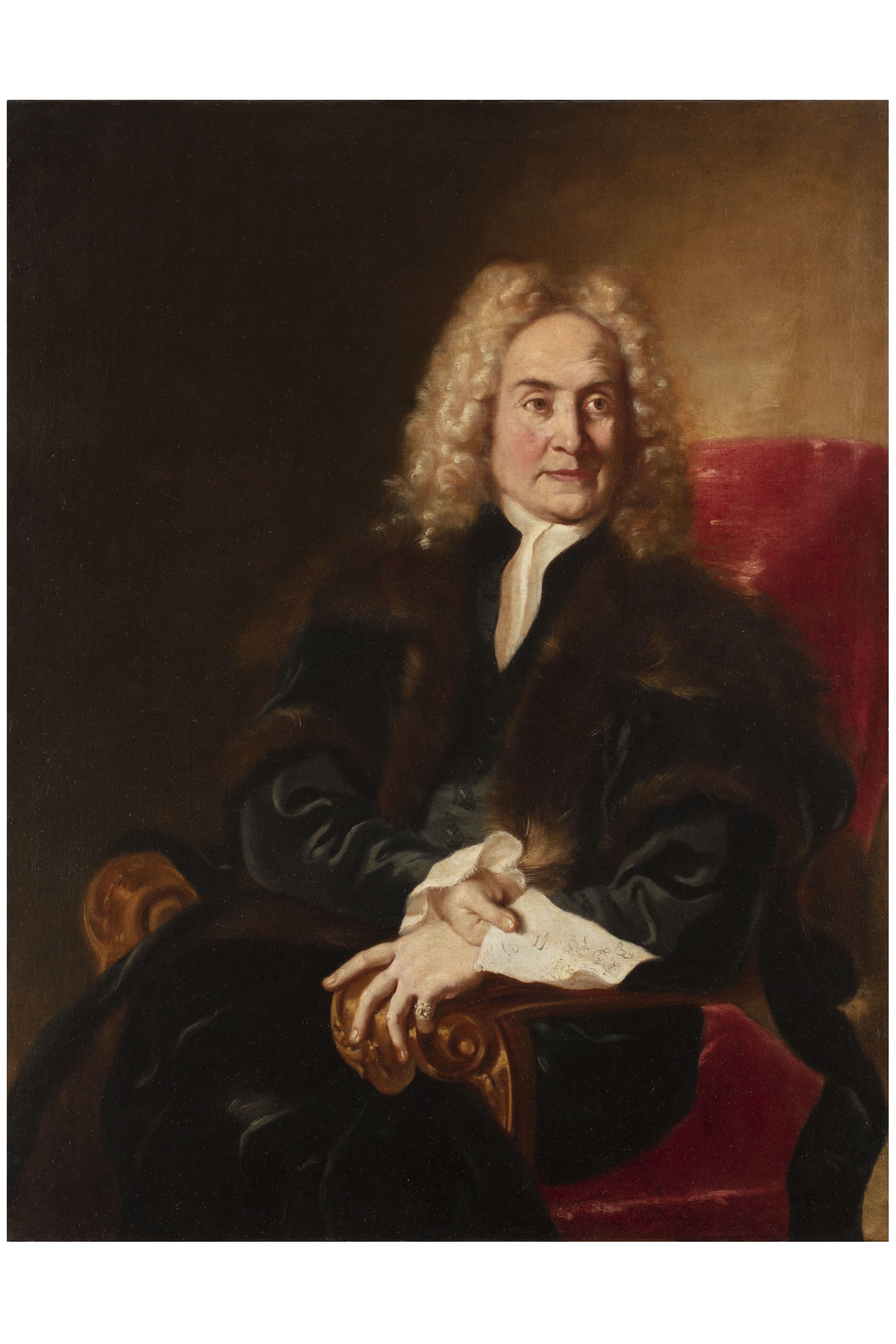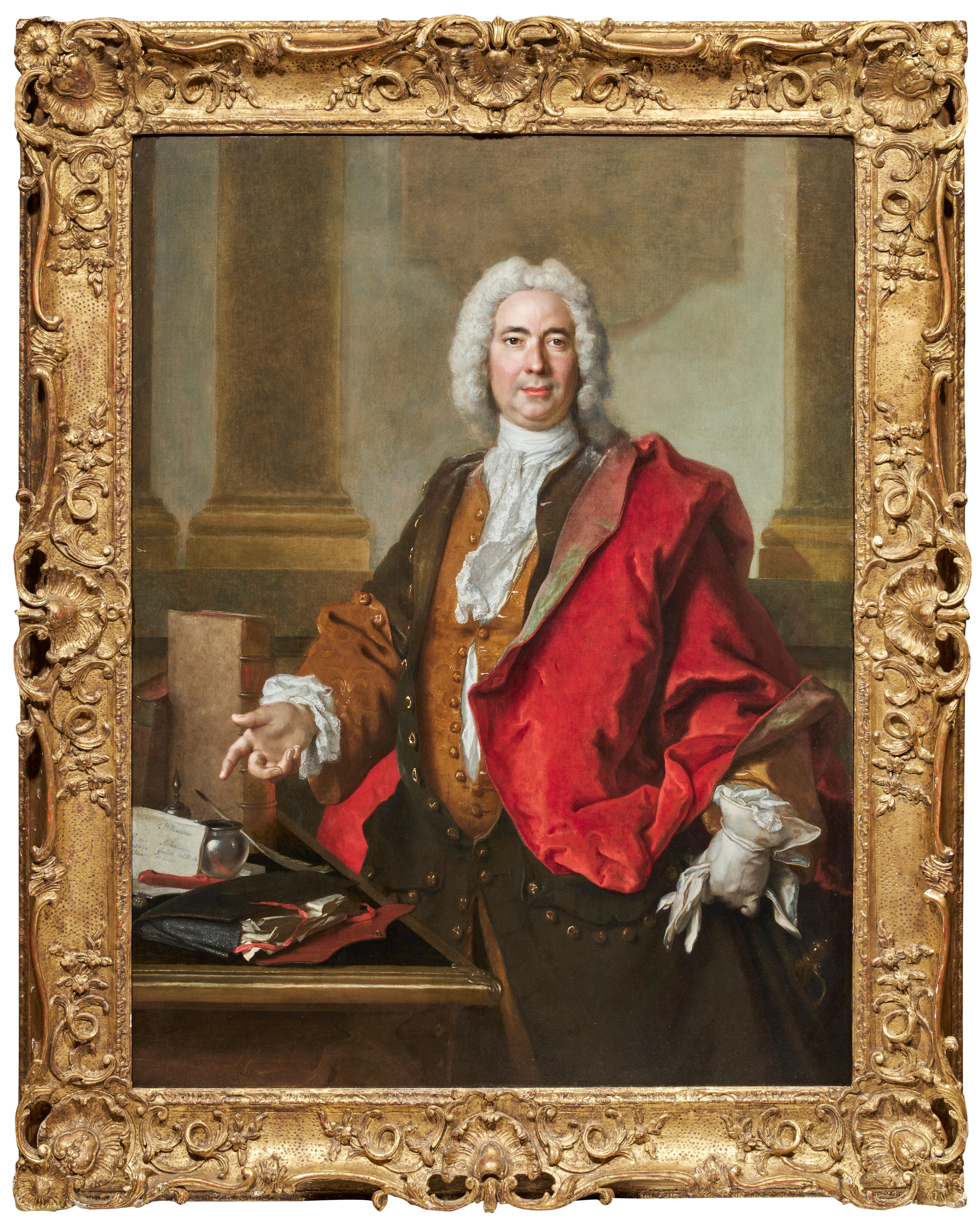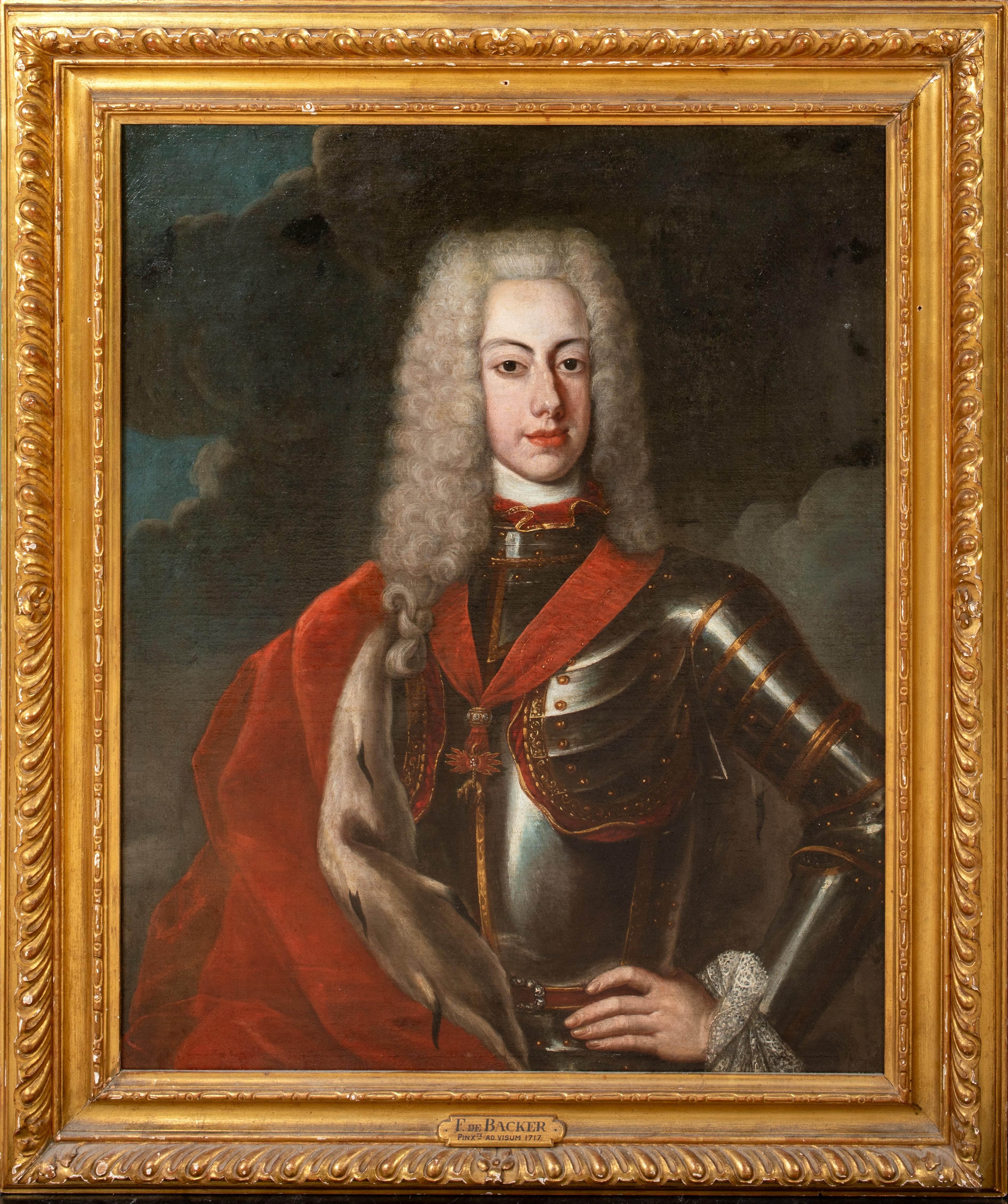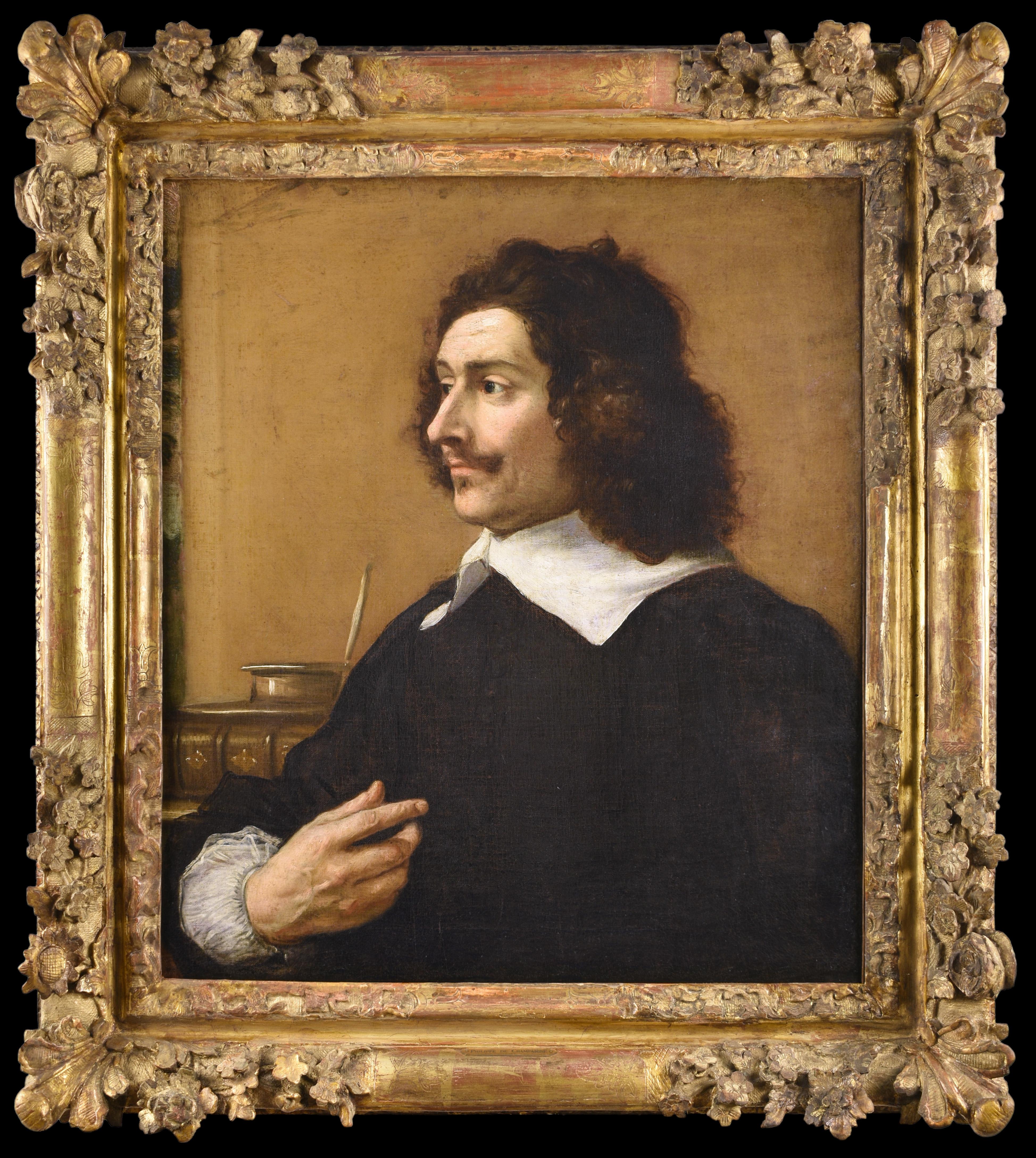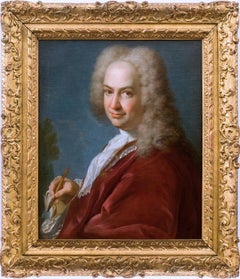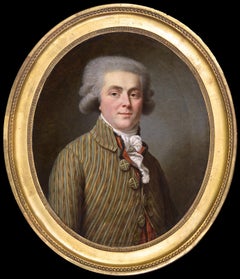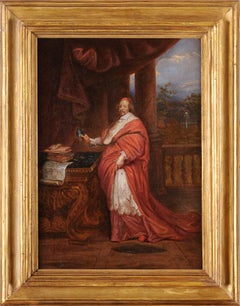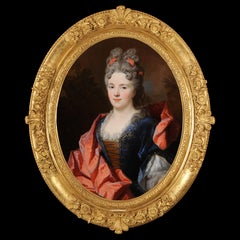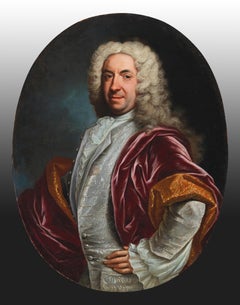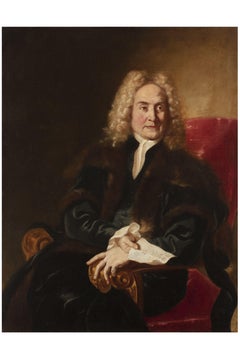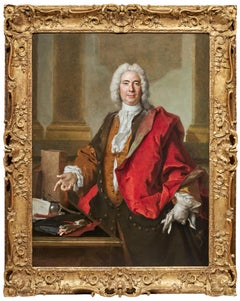Items Similar to Italian men portrait
Want more images or videos?
Request additional images or videos from the seller
1 of 11
Giovanni Maria delle Piane dit Mulinaretto (Genoa 1670 - Monticelli d´Ongina 1745)Italian men portraitCirca 1740
Circa 1740
$44,258.30
£33,526.68
€38,000
CA$61,313.90
A$68,767.61
CHF 36,012.53
MX$835,593.54
NOK 457,298.85
SEK 433,551.53
DKK 289,323.12
About the Item
Giovanni Maria DELLE PIANE, known as IL MULINARETTO
(Genoa, 1660 – Monticelli d'Ongina, 1745)
Portrait of a man
Oil on oval canvas
H. 108 cm; L. 83 cm
Provenance: Nino Ferrari Collection, Genoa,1922
Exhibition: 1922, “Mostra della pittura italiana del Seicento et del Settecento”, Florence, Palazzo Pitti, n° 707 (Label on the frame)
The artist, better known as his nickname Mulinaretto, inherited from a miller grandfather, was born in Genoa in 1660. At the age of ten, he began attending the workshop of Giovan Battista Merano, where he completed his apprenticeship as a painter and where There he remained until 1676, when he moved to Rome, to improve under the direction of Giovan Battista Gaulli, il Baciccio. It was during this stay in Rome, which lasted about eight years, that the young man developed “the frank ability to translate with accuracy the most delicate and difficult physiognomies on the canvas” (Ratti 1769, p. 147). , thus demonstrating a remarkable aptitude for portraiture. Returning to Genoa in 1684, he was thus able to take advantage of his ability to paint humans, responding to the taste of the local clientele who recognized him as a gifted, sensitive artist, skilled in satisfying their needs for social recognition, according to a taste which was changing during this decade. The first works of the Mulinaretto, such as the portraits of the doge Pietro Durazzo (Genoa, National Gallery of Palazzo Spinola), of Gian Battista Cattaneo and his wife Maddalena Gentile with a daughter (Genoa, former collection of the Società Levante Assicurazioni) are included still in the style of Genoese portraiture from the first half of the 17th century, according to the methods of Gio Bernardo Carbone, a disciple of Van Dyck. It was probably towards the end of the century, during the last decade of the 17th century, that the artist renewed his style, adapting to the new fashion for French portraiture in the genre of Rigaud and Largillièrre. Works such as the portraits of the Doria House and the Durazzo House are characterized by a pleasant “worldliness” and a refined invention of backgrounds, sometimes even sumptuous. In 1695, il Mulinaretto, invited by Count Morando, made his first trip to Parma, a city in which he stayed several times, finding favor with the Farnese family: in 1706, the artist painted the portrait of Duke Francesco, of the Duchess Dorothée and Princess Elisabetta Farnese. After also making a few trips to Milan, Delle Piane moved to Parma in 1709, where he was appointed court painter. He returned to Genoa several times to respond to commissions, around 1714 and 1715, where he immortalized Elisabetta Farnese on the occasion of her marriage to Philip V of Spain; in this same period he lived in Piacenza, where he remained until 1737. It was probably in these years, around the middle of the second decade of the 18th century, that the artist found a more personal way, in which his various cultural references emerge, mixing its Italian and French inspirations. In 1719, il Mulinaretto declined the invitation to go to Spain, probably given by Elisabetta Farnese. Several years later, in 1737, he spent a stay in Naples, at the court of Charles Bourbon, son of Elisabetta. As a chamber painter, he depicted King Charles and his wife there. In 1741, the artist left Naples for Genoa, where he still painted the local nobility before retiring in 1744 to Monticelli d'Ongina near Piacenza, where he died the following year.
- Creator:Giovanni Maria delle Piane dit Mulinaretto (Genoa 1670 - Monticelli d´Ongina 1745) (1670 - 1745, Italian)
- Creation Year:Circa 1740
- Dimensions:Height: 42.52 in (108 cm)Width: 32.68 in (83 cm)
- Medium:
- Movement & Style:
- Period:1740-1749
- Condition:
- Gallery Location:BELEYMAS, FR
- Reference Number:1stDibs: LU1857215632092
About the Seller
3.0
Vetted Professional Seller
Every seller passes strict standards for authenticity and reliability
Established in 2017
1stDibs seller since 2022
5 sales on 1stDibs
- ShippingRetrieving quote...Shipping from: BELEYMAS, France
- Return Policy
Authenticity Guarantee
In the unlikely event there’s an issue with an item’s authenticity, contact us within 1 year for a full refund. DetailsMoney-Back Guarantee
If your item is not as described, is damaged in transit, or does not arrive, contact us within 7 days for a full refund. Details24-Hour Cancellation
You have a 24-hour grace period in which to reconsider your purchase, with no questions asked.Vetted Professional Sellers
Our world-class sellers must adhere to strict standards for service and quality, maintaining the integrity of our listings.Price-Match Guarantee
If you find that a seller listed the same item for a lower price elsewhere, we’ll match it.Trusted Global Delivery
Our best-in-class carrier network provides specialized shipping options worldwide, including custom delivery.More From This Seller
View AllPresumed artist self-portrait
Located in BELEYMAS, FR
Louis-Gabriel BLANCHET
(Versailles, 1701 – Rome, 1772)
Presumed self-portrait of the artist
Oil on canvas
H. 73 cm; W. 60 cm
Circa 1730
Originally presented in a Restoration period frame with a "Mignard" cartouche, this beautiful painting initially appeared to us as a work from northern Italy. However, it exuded a rather French form of refinement, suggesting that its artist may have assimilated a dual influence from both sides of the Alps.
We thank our colleague and friend Philippe Mendès for spontaneously and judiciously "bringing out" the name of Louis-Gabriel Blanchet, a Romanized French portraitist, whose spirit and stylistic characteristics we clearly recognize here.
Blanchet's "French" years, before his final departure for Rome in 1728, following his winning of the second Grand Prix for painting after Subleyras in 1727, are extremely poorly documented. His father, Gabriel, was valet to Blouin, himself Louis XIV's first valet at the time. According to Thierry Lefrançois, Blanchet was one of the few students of Nicolas Bertin (1667-1736), whose studio he is said to have joined in the early 1720s. At a baptism on March 24, 1724, where he was godfather, he is mentioned as a painter in the picture store of the Duke of Antin, the director of buildings between 1708 and 1736. At this time, he was probably already married to Jeanne Quément, with whom he had a daughter also named Jeanne, who would marry Nicolas Aviet, the son of a valet in the queen's wardrobe, in Versailles in 1738.
When Blanchet arrived in Rome in October 1728, he was accompanied by Subleyras, Trémolières, and Slodtz. He enjoyed the goodwill of Vleughels, the director of the Académie de France, which had been based at the Palazzo Mancini since 1725, even though the latter was not always kind to our resident. From 1732, he was under the protection of the Duke of Saint-Aignan when he took up his post as ambassador to Rome. Along with Slodtz and Subleyras, they formed a trio of friends, joined by Joseph Vernet shortly after his arrival in Rome in 1734. Slodtz and Blanchet, on the occasion of Subleyras's marriage in 1739, were there to attest that their friend was not bound by any marital commitment, and Blanchet was a witness at Vernet's wedding in 1745.
It is most likely from these early years in Rome that our portrait of the artist dates, the expression and turn of his face irresistibly reminiscent of a self-portrait. The still relatively youthful features may correspond to Blanchet's thirty-something years, and the fluffy wig was still fashionable at this time.
The painting fits well with the depiction of a young painter wanting to display both the beginnings of success and a certain simplicity or restraint. A slight smile expresses a form of assurance in this man with a gentle, sincere gaze and a face radiating a keen sense of wit. We find here the air of intimacy present in almost all of Blanchet's portraits, even those from the 1750s and 1760s, as well as an almost complicity with the viewer. The spirit of the painting is quite close to that of the presumed portrait of Bouchardon (painted around 1730) and the portrait of Pannini, painted in 1736, but it possesses a more natural quality, notably thanks to the absence of decorum. Our work exhibits the characteristics of Blanchet's paintings: elegance, luminosity (especially in the whites), vibrant and refined colors (here, the harmony of the garnet of the garment and the slate blue of the background, whose uniformity is tempered by a very sketched landscape and a grove of greenery), light complexions, rather rosy cheekbones, often full lips, and rather tight framing.
According to the Academy's rules, Blanchet's stay should have ended in the spring of 1732, but, for reasons unknown, he remained in the Eternal City until his death, as did his friend Subleyras, with whom he shared accommodation until the late 1730s. The latter regularly called upon him to collaborate on his paintings, such as The Meal at Simon's. Through Saint-Aignan's intervention, Blanchet was employed in the late 1730s by the Stuart princely family, then exiled in Italy. He notably produced copies (now lost) after Liotard of the portraits of Charles Edward and Henry Benedict, the sons of James III Stuart. The latter also commissioned three other portraits (now in the National Portrait Gallery in London), whose more formal character contrasts with the intimate spirit of Blanchet's portraits. Blanchet frequented English painters, such as the landscape painter Richard Wilson, and studied with the Scottish portraitist Katherine Read...
Category
1730s French School Portrait Paintings
Materials
Oil, Canvas
Portrait of a man during French Revolution
Located in BELEYMAS, FR
Antoine VESTIER, attributed to
(Avallon, 1740 - Paris, 1824)
Portrait of a man under the Revolution
Oil on canvas
H. 46 cm; L. 37 cm
Circa 1793-95
This beautiful unsigned portrait i...
Category
1790s French School Figurative Paintings
Materials
Canvas, Oil
Cardinal Mazarin portrait
Located in BELEYMAS, FR
French School circa 1645
Portrait of Cardinal Mazarin - Sketch
Oil on canvas
H. 41.5 cm; W. 27 cm
Provenance: Collection of the Reverend Georges Downing Bowles (1789-1863)
Would ...
Category
1640s French School Portrait Paintings
Materials
Canvas, Oil
Presumed portrait of Marie-Anne de Bourbon
By Nicolas de Largillière
Located in BELEYMAS, FR
Nicolas de LARGILLIERRE
(Paris 1656 – 1746)
Portrait of a woman, presumed to be Marie-Anne de Bourbon, Princess of Conti (1666-1739)
Oil on oval canvas
H. 8...
Category
Early 1700s French School Figurative Paintings
Materials
Canvas, Oil
Portrait of a man in armor
Located in BELEYMAS, FR
Attributed to Jacques DUMONT aka DUMONT LE ROMAIN
(Paris 1701 - 1781)
Presumed portrait of Louis-Joseph de Formanoir (?-1732)
Oil on canvas
H. 91.5 cm; L. 73 cm
Signed on the helmet:...
Category
1750s French School Portrait Paintings
Materials
Canvas, Oil
Portrait of a couple
Located in BELEYMAS, FR
Jean-Baptiste SANTERRE
(Magny en Véxins 1651 - Paris 1717)
Portrait of a couple
Oil on original oval canvas
H. 115 cm; L. 90 cm (140 x 115 cm with frame)
Around 1695
Jean-Baptiste S...
Category
1690s French School Portrait Paintings
Materials
Canvas, Oil
You May Also Like
Baroque Portrait of a gentleman 18th century Italian master by Domenico Parodi
By Domenico Parodi (Genoa, 1672 - 1742)
Located in Stockholm, SE
We are grateful to Prof. Daniele Sanguineti for suggesting the attribution to Domenico Parodi (1672 - 1742). He dates the painting into the period between 1730 and 1740. Domenico Par...
Category
1730s Realist Portrait Paintings
Materials
Canvas, Oil
17th-18th Century By Niccolò Cassana Portrait of a Gentleman Oil on Canvas
Located in Milano, Lombardia
Niccolò Cassana (Venice, Italy, 1659 - London, UK, 1714)
Title: Portrait of a Gentleman
Medium: Oil on canvas
Dimensions: without frame 119.5 x 92.5 cm
Painting without frame.
Expe...
Category
17th Century Old Masters Portrait Paintings
Materials
Oil, Canvas
Portrait Gentleman Rigaud 18th Century Paint Oil on canvas Old master French Art
Located in Riva del Garda, IT
Hyacinthe Rigaud (Perpignan 1659 - Paris 1743) School of
Portrait of a gentleman in armour: Joseph Jean Raymond de Lasbordes, Officer of the “Régiment des Landes” (infantry regime...
Category
18th Century Old Masters Paintings
Materials
Oil
$9,569 Sale Price
20% Off
Portrait of Monsieur Aubert, a ceremonial portrait by Nicolas de Largillière
By Nicolas de Largillière
Located in PARIS, FR
Provenance :
Arnold S. Kirkeby (1901-1962)
Donated by Arnold S. Kirkeby to the Los Angeles County Museum of Art in 1955, where it remained until its sale at Sotheby's, New York on Ja...
Category
1720s Old Masters Portrait Paintings
Materials
Oil
Portrait Holy Roman Emperor Charles VI (1685-1740), 18th Century Franz De Backer
Located in Blackwater, GB
Portrait Holy Roman Emperor Charles VI (1685-1740), 18th Century
bv Franz De Backer (1680-1749)
Large early 18th Century portrait of Charles VI, ruler of t...
Category
18th Century Portrait Paintings
Materials
Canvas, Oil
$4,201 Sale Price
35% Off
Portrait of a Nobleman, French School 17th Century
Located in New York, NY
French portrait of a nobleman, 17th Century, great condition. With a beautiful carved wooden frame.
Category
17th Century Baroque Portrait Paintings
Materials
Canvas, Oil
More Ways To Browse
Antique Oval Portrait
Antique Invitations
French Oval Portraits
Oval Italian Painting
Charles Counts
Spanish Canvas 17th
Painting Of Bourbon
V Miller
Giovanni Battista Gaulli
Jonathan Richardson
Peter Max Zero
17th Century Portrait Of A Noblewoman
Carlo Dolci
Circle Of Sir Godfrey Kneller
Franz Xaver Winterhalter
John Vanderbank
Le Sueur
Natasha Law
